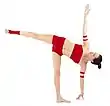Astavakrasana
Astavakrasana (Sanskrit: अष्टावक्रासन; IAST: Aṣṭāvakrāsana) or Eight-Angle Pose[1] is a hand-balancing asana in modern yoga as exercise dedicated to the sage Astavakra, the spiritual guru of King Janaka.[2]


Etymology and origins
The name comes from the Sanskrit words अष्टा ashta meaning "eight", वक्र vakra meaning "bent, curved", and आसन asana meaning "posture" or "seat"; or alternatively from the myth of the sage Astavakra.[2]
The pose is unknown in hatha yoga until the 20th century Light on Yoga, but the pose appears in the 1896 Vyayama Dipika, a manual of gymnastics, so Norman Sjoman suggests that it is one of the poses adopted into modern yoga in Mysore by Krishnamacharya. The pose would then have been taken up by his pupils Pattabhi Jois and B. K. S. Iyengar.[3]
Mythology

Astavakra was the spiritual guru of King Janaka, father of Sita. When he was in his mother's womb, his father Kagola recited the Vedas inaccurately, making the unborn child laugh. Kagola, furious, put a curse on the baby to be born bent in eight places, "Astavakra" meaning eight bends. Kagola was defeated in debate with the court scholar, Vandi. The young Astavakra beat Vandi in argument, and became Janaka's guru. His father blessed him for this, and his deformity vanished.[2]
Description
Astavakrasana is a hand balance with lateral twist. The pose is entered from a squatting position, one arm between the feet, the other just outside the other foot, palms on the floor. Pushing up and lifting both legs from the floor gives a variant or preparatory position, with both legs bent, one leg over one forearm, the other leg crossed over the first at the ankle. Straightening the legs gives the full pose.[2][4][5][1]
Claims
Twentieth century advocates of some schools of yoga, such as B. K. S. Iyengar, made claims for the effects of yoga on specific organs, without adducing any evidence.[6][7] Iyengar claimed that this pose "strengthens the wrists and develops the muscles of the abdomen".[8]
See also
- Koundinyasana, a similar twisting arm-balancing asana
- List of asanas
References
- YJ Editors (22 April 2008). "Eight-Angle Pose". Yoga Journal.
- Iyengar, B. K. S. (1966). Light on Yoga. HarperCollins. pp. 276–277.
- Sjoman, Norman E. (1999). The Yoga Tradition of the Mysore Palace. Abhinav Publications. pp. 55, 100–101. ISBN 81-7017-389-2.
- Schumacher, John (28 August 2007). "Astavakrasana (Eight-Angle Pose)". Yoga Journal.
- "Astavakrasana - Eight angled pose". itsafablife.com. 25 July 2013. Archived from the original on 14 April 2017. Retrieved 7 July 2015.
- Newcombe 2019, pp. 203-227, Chapter "Yoga as Therapy".
- Jain 2015, pp. 82–83.
- Iyengar 1979, p. 278.
Sources
- Iyengar, B. K. S. (1979) [1966]. Light on Yoga: Yoga Dipika. Unwin Paperbacks. ISBN 978-1855381667.
- Jain, Andrea (2015). Selling Yoga : from Counterculture to Pop culture. Oxford University Press. ISBN 978-0-19-939024-3. OCLC 878953765.
- Newcombe, Suzanne (2019). Yoga in Britain: Stretching Spirituality and Educating Yogis. Bristol, England: Equinox Publishing. ISBN 978-1-78179-661-0.
_from_Jogapradipika_1830_(detail).jpg.webp)
